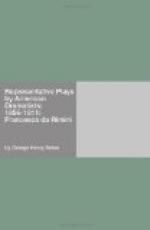Dear old Charley, you are the only man living with whom I can play the fool through a long letter and be sure that I shall be clearly understood at the end. To say that this privilege is cheerful is to say little, for it is the breath of life to a man of a certain humour.
The “Francesca” note, therefore, is typical of Boker’s enthusiasm. When Stoddard read the play, we wonder whether he saw in it any similarities to Leigh Hunt’s poem on the same subject? For once he had detected in Boker’s verses the influence of Hunt. There are critics who claim Boker had read closely Hugo’s “Le Roi s’Amuse.” But there is only one real comparison to make—with Shakespeare, to the detriment of Boker. His memory beat in Elizabethan rhythm, and beat haltingly. The present Editor began noting on the margin of his copy parallelisms of thought and expression in this “Francesca” and in the plays of Shakespeare; these similarities became so many, were so apparent, that it is thought best to omit them. The text used is not based on the manuscripts left by Boker, nor has it been compared with the acting copy made, in 1855, for E.L. Davenport, as has already been done elsewhere in print. I have preferred to use the text finally prepared by Boker for his published plays, this being the one which met with his approval. In 1882, Lawrence Barrett, with the aid of William Winter, prepared an acting version of “Francesca,” and it was this which Mr. Otis Skinner used, when he revived the piece in 1901.
A notice in The New York Tribune for 1882 suggests that when E.L. Davenport first essayed “Francesca da Rimini,” in 1855, it was in one-act. I can find no corroboration of this statement. The play-bill here reproduced specifically announces a five act tragedy, and it is to be inferred that the form of the play, as given at the Broadway Theatre, New York, September 26, 1855,[B] was the only one used by him. Winter claims that as Lanciotto, Davenport was “unimaginative, mechanical, and melodramatic,” and that the whole piece “proved tedious.” This is strange, considering the heroic and romantic characteristics in Davenport’s method of acting. It may be that he attempted Boker’s play because of his interest in the development of American drama. He had assisted Mrs. Mowatt in her career as playwright, and, during his full life, his name was identified with Boker’s “Calaynos,” George H. Miles’s tragedy, “De Soto, the Hero of the Mississippi,” and Conrad’s “Jack Cade.” But the concensus of opinion is that Boker’s “Francesca da Rimini,” as given by Davenport, was a failure.




